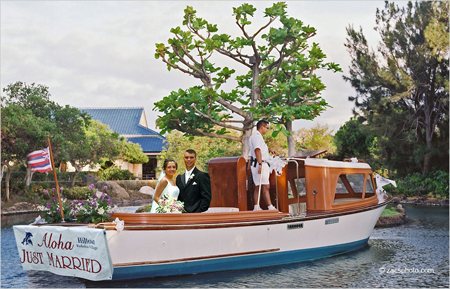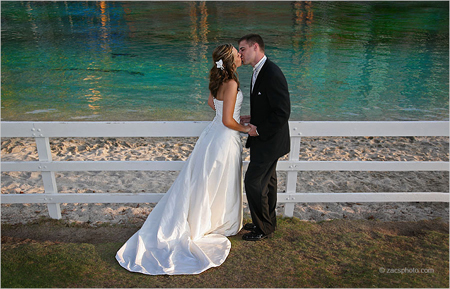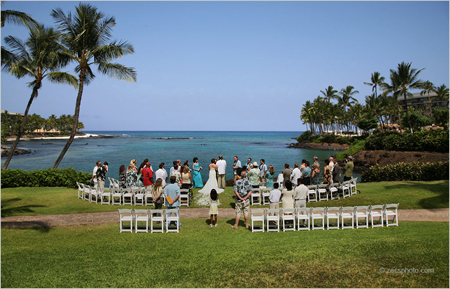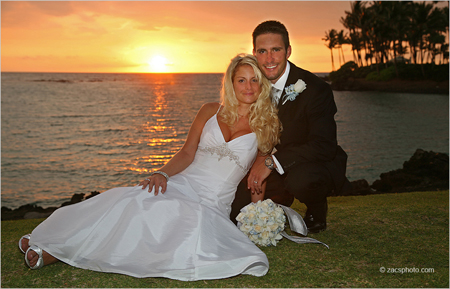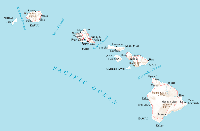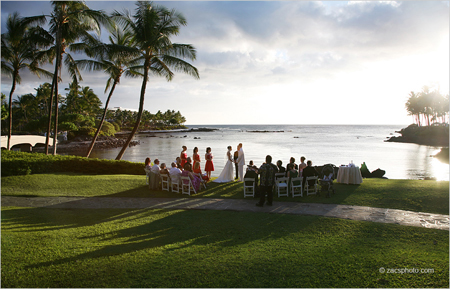 Photo courtesy of Zac's Photo of Hawaii
Photo courtesy of Zac's Photo of Hawaii
Weddings in Hawaii are frequently held outdoors on the beach, in a tropical garden, or even on a boat sailing off beautiful Waikiki. The islands of Maui and Kauai are favorite honeymoon locations because of their quiet, romantic beauty. Read our comprehensive guide on Hawaiian wedding traditions and customs to see how you may incorporate them into your big day.
~ By Reverend RC Eckert, D.D.E ka Haku,ekokua mai ia maua e ho'omana'o i ka manawa a maua i launa mua ai,
Lord, help us to remember the time we first met,a me ke aloha nui i ulu ai ma waena o maua.
And the strong love that grew between us.E kokua mai ia maua a ho'ohana i kela aloha i na mea mma'amaau i'ole e ka;awale.
Help us to apply that love in practical things so nothing divides us.Ke nonoi ha'aha'a nei maua i na hua'olelo 'olu'olu a piha me ke aloha,
We humbly ask for kind words filled with love,a no na pu'uwai makaukau mau a noi i ka huikala, a e huikala aku.
And for hearts always ready to ask forgiveness, as well as to forgive.
E ka Haku, ke waiho nei maua i ko maua male'ana i loko o ku Lima.Amene.
Lord, we leave our marriage in your hands. Amen.
At Japanese weddings, it is customary for friends and relatives to offer "banzai" toasts to the bride and groom, wishing them long life.
It is customary for a Japanese-American bride to fold 1,001 paper cranes prior to her wedding for good luck and long life. Although the traditional Japanese custom calls for 1,000, people in Hawaii add one more for good luck.
It is customary at Hawai'i weddings, especially at Filipino weddings, for the bride and groom to do a "money dance" (also called the pandango). As the bride and groom dance, the guests express their best wishes to the newlyweds with a monetary gift.
Please feel free to contact us with your comments, and any other traditions which you would like us to include. Enjoy!
Hawaiian Music
The beautiful "Hawaiian Wedding Song" made famous by Elvis in the movie "Blue Hawaii" is usually sung at the ceremony. This song had originally been written in Hawaiian by Charles E. King in 1926. It had been given English lyrics by Hoffman and Mannin. Elvis's version is a dual-language version of both songs. He sang it to his bride at his own wedding. As a direct result of the film, about 500 Americans per year were married at the Coco Palms Resort, and most of them used the famous song as part of the ceremony. Even after the hotel closed in 1992, the song is still a popular choice, especially for Presley fans.
Hawaii has a wide range of musical styles and instruments. The slack key (a regional guitar style), the ukulele and steel guitar are popular musical instruments.Hawaiian Food
Modern Hawaiian cuisine is a fusion of many cuisines brought by multi-ethnic immigrants to the islands, particularly of American, Chinese, Filipino, Japanese, Korean, Polynesian and Portuguese origins, and including food sources from plants and animals imported for Hawaiian agricultural use from all over the world.
Your wedding feast might include some of these regional favorites: sweet and sour pineapple country ribs, creamy portuguese grits with sauted shrimp, hirame sashimi with ponzu sauce, crabmeat stuffed hirame, moi poke, poached or fried moi with shoyu sauce, vegetable tofu, chicken salad, shrimp, crab cakes, lobster and salmon. Fresh fruit might include pineapple, mangos, coconuts, kiwi, oranges and star anise.These recipes and other island favorites are available at Sam Choy Recipes, which are provided by NEWS 8-NBC HAWAII and KFVE-TV-The Home Team of Hawaii. 100% Maui coffee with 100% originality. Save 20% and shipping is free with promo code COFFEE20 at checkout!![]()
A special note: no alcoholic beverages are allowed on public beaches and parks in the State of Hawaii.
Wedding Attire & Flowers
The bride wears a long, white formal version of the muumuu called a 'holoku.' Instead of a veil, a woven garland of island flowers, 'haku lei', is worn around her head. The bride's bouquet may consist of white orchid sprays.The groom wears a long sleeve white shirt and white pants. A long red, or colored sash, is worn wrapped about his waist. A lei of maile and ilima flowers adorn his neck.
Hawaiian wedding bands bearing the couple's name in Hawaiian are often exchanged. The name 'kuuipo', meaning sweetheart, is a favorite choice for the bride.
We are frequently asked questions about flowers worn by the bride. Here is what Joyce of Zacsphoto.com provided:
Usually brides do not change the location of a flower in their hair on their wedding day. I think that is probably because the hair stylist has placed the flower in a strategic location, and to move the flower could turn a good hair day into a bad one. As far as we have witnessed, if a bride wears flowers in her hair, they are placed on the left side, which signifies she is taken. The flowers are not moved during the ceremony.
 Hawaiian Wedding Photographers
Hawaiian Wedding Photographers
Please select the island where your wedding will be held. If you need help in choosing a location, please contact one of our photographers for recommendations. Mahalo!
General Hawaiian Customs
The customary way to welcome or congratulate someone is to present him or her with a lei, a garland of flowers (or other decorative items) strung together and worn around the neck. One puts the lei over the recipient's head and if the relationship is close, gives the recipient a honihoni or a kiss. Lei are especially appropriate for high school and college graduations, birthdays etc. Children often appreciate candy or money lei. It is considered bad luck to throw a lei away. When the lei is no longer wearable, some people cut the string and cast the individual flowers into the ocean. Others may hang the withering lei somewhere inside or outside the house. A lei is love, and one doesn't throw away love.
Older people may be called "auntie" or "uncle" by friends, neighbors, and even complete strangers. No blood relationship is implied. While "aunties" and "uncles" are often old family friends, it can also be appropriate to address an elderly stranger as "auntie" or "uncle." This is considered respectful but friendly. The use of formal titles such as "Mr." or "Mrs." feels cold and unfriendly to many island residents.
Everyone is expected to remove his/her footwear before entering a home or other place of residence.
In most settings (with the exception of sporting events and concerts), it is considered rude to speak loudly or act as if one were entitled to special treatment. Politeness and reserve are considered to show good breeding.
It is considered rude to stare or make excessive eye contact in public places.
For men in business or professional roles, an aloha shirt and slacks are the norm. Suits and ties are rarely worn.
When visiting a home, it is considered good manners to bring a small gift (for example, a dessert) for one's host.
The offering of food is related to the gift-giving culture. The pidgin phrases "Make Plate" or "Take Plate" are common in gatherings of friends or family that follow a pot-luck type format. It is considered good manners to "make plate", literally making a plate of food from the available spread to take home, or "take plate", literally taking a plate the host of the party (or the aunties running the kitchen) has made of the available spread for easy left-overs. It is gracious to take the plate, or make a small plate, even if you don't intend to eat it. In part, this tradition is related to clean-up, being a good guest by not leaving the mass of left-overs at the party-throwers house and making them alone responsible for clean up. In more recent times, this has also evolved into donating your left-overs to the homeless population, especially if you're having a get-together at a public park or similar location, as it is likely there is a homeless population living nearby as well.
It is considered thoughtful to bring back gifts from a trip for friends and family. Some people use the Japanese name for such gifts, omiyage. Others use the Hawaiian word, "makana". Gifts of special foods unavailable outside the region visited are particularly appropriate.
Resources and References
Special Thanks to Sandy Sawin of Hawaii for gathering a portion of the information used here.Wikipedia.org: Hawaiian Customs and Etiquette
Please note that the information contained in this category should be considered general in nature. We believe it to be a true and accurate representation of some of the customs and traditions for this country or religion. Information provided by individuals and organizations is assumed to be correct.
You are welcome to email us at join@weddingdetails.com with any suggestions for changes, additions or deletions.

